#protozoan parasite
Photo

(via Behavior-changing parasite moves wolves to the head of the pack | Ars Technica)
Toxoplasma gondii is a ubiquitous protozoan parasite that can infect any warm-blooded species. In lab studies, infection with T. gondii has been shown to increase dopamine and testosterone levels along with risk-taking behaviors in hosts including rodents, chimps, and hyenas. Oh, and humans.
#what the actual fuck#Behavior-changing parasite#Toxoplasma gondii#protozoan parasite#increase dopamine and testosterone#in mammals#science#tech
45 notes
·
View notes
Text
my friend who is also an autistic transmasc named jasper is texting me about protozoan parasites
#mine#being friends w other autistic transmascs is all fun and games until they pull out the history of protozoan parasites#vibe palace
12 notes
·
View notes
Photo

#Repost @felixjtapia Posted @withrepost • @sciencephotolibrary Have you heard of Trichomoniasis? It is a parasitic microorganism that is the causative agent of trichomoniasis. Trichomoniasis is a common cause of vaginitis and is a sexually transmitted disease. This is an illustration of Trichomonas vaginalis parasite by Tim Vernon. Credit: Tim Vernon / Science Photo Library C056/3605 #artwork #biological #biology #flagella #illustration #infection #infectious #parasite #parasitic #protozoa #protozoan #sexuallytransmitteddisease #sexuallytransmittedvaginitis #std #sti #trichomoniasis #science #sciart #sciencephoto #scienceart #medicalart https://www.instagram.com/p/Ci2a1NwuR8N/?igshid=NGJjMDIxMWI=
#repost#artwork#biological#biology#flagella#illustration#infection#infectious#parasite#parasitic#protozoa#protozoan#sexuallytransmitteddisease#sexuallytransmittedvaginitis#std#sti#trichomoniasis#science#sciart#sciencephoto#scienceart#medicalart
2 notes
·
View notes
Photo

#studyblr#notes#medblr#medical notes#med notes#sporozoa#protozoans#parasites#parasitology#microbiology#parasitology notes#microbiology notes#microbio#microbio notes#pseudopodia#malaria#p vivax#plasmodium#plasmodium vivax
3 notes
·
View notes
Note
What’s your favorite turtle and also favorite parasite?
How could I ever choose?! I can’t pick absolute favorites but I can definitely choose some top contenders
Turtles:
- Alligator snapping turtle (I deeply love any type of snapper but these guys are just totally something else- once you work with one you’re hooked forever)
- Gopher tortoise (keystone species with talk show host level charisma)
- Bog Turtles (the cutest animal on earth??)
- Radiated tortoise (I love all the Madagascar tortoise species but these take my breath away)
- Eastern box turtle (if these dudes don’t fill you with childlike wonder I don’t get you)
- Diamondback terrapin (makes me feel how I assume old white guys feel when they see a fancy muscle car. Just a great looking kickass turtle here)
Parasites:
- Screwworms (parasitic larvae of a fly but terrifying and fascinating- these worms are the reason we have sterile insect technique)
- Toxoplasma gondii (best parasite to go down the rabbit hole researching; this protozoan is running the world)
- Parasitic wasps are morbidly fascinating to me so I’ll also say Jewel wasp (can perform brain surgery on the exact part of a cockroach’s brain that would allow it to escape)
- Any type of pentastomid (mysterious and cool, will never forget finding a dead snake filled to the brim with them)
- Guinea worm (interesting worm with cool history and life cycle- former US president Jimmy Carter once vowed to eradicate this parasite in his lifetime)
98 notes
·
View notes
Text
Fellas, time to start cat-maxxing
70 notes
·
View notes
Text
Tropical Milkweed, Its Problems, and What To Plant Instead
I am writing this to atone for the sins of my past (handing out tropical milkweed cuttings to my friends and teachers before I knew better).
(Also let me make this clear I am Floridian I am writing this from the perspective of someone in the United States if you live in Tropical Milkweed's native range this doesn't apply to you go forth pogchamp)
Look online, on TV, in books, in newspapers, left, right, up, down, anywhere, and you'll see people talking about how planting milkweed is crucial, essential for the survival of monarch butterflies. Milkweed is the only plant that monarch caterpillars can eat as they're growing, and the loss of it in our wild spaces is one of the most direct links to the ecological extinction speedrun of not just monarchs, but dozens of other insects who rely on its abundance of nectar-filled flowers to survive. You'll be urged to run, not walk, to your nearest garden center, buy as much milkweed as you can, and hurry fast to plant it in your gardens and be part of the solution, not the problem. The issue is that, oftentimes, the milkweed you leave the store with is a vibrant red and orange, with pointed green leaves, dozens like it lining the shelves across stores all over the nation...
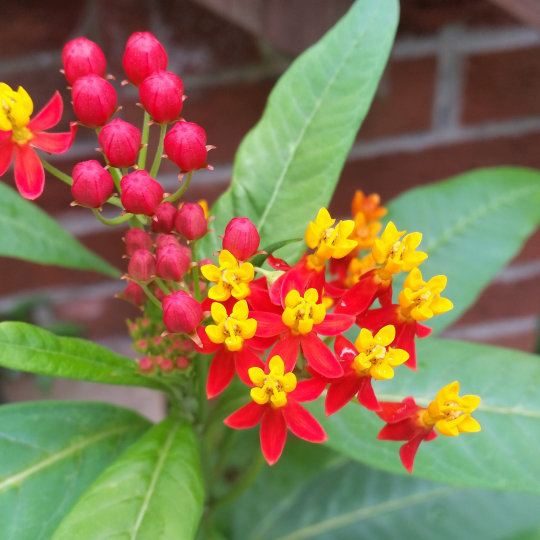
Tropical milkweed. Scarlet milkweed. Bloodflower. Mexican butterfly weed. Asclepias curassavica. This plant is a being of many names, and our culprit of the hour.
'Culprit? Culprit of what?' Culprit of enticing people to buy it under the guise of helping, only to possibly cause more harm than good.
Let's discuss.
Tropical Milkweed (Asclepias curassavica) is a gorgeous milkweed (especially the yellow variety? ooh, that had me in a grip as a teen) that's easy to obtain--too easy. It lines the shelves of stores like Walmart, Lowe's, Home Depot, and even hundreds and dozens of smaller garden stores, and is sold for reasonably cheap because its quick and easy to grow from seed and eagerly roots from cuttings. It's extremely popular with butterflies too--in many scenarios, Tropical Milkweed will be preferred as host plants over other related species like Butterflyweed (Asclepias tuberosa), and its also popular with other species of butterfly, bees, and wasps as a nectar source. It lasts well into winter in some areas of the United States, is quick to regrow when cut back, and doesn't die back for periods of the season like some other milkweeds do. It's eager to reseed, creating capsules with tens of dozens of seeds and scattering across the winds with the help of little silky parachutes much like the ones dandelions are known for.
'Ani, what's the problem with that? This all sounds like its great for monarchs!'
See, here's the kickers. In fact, here's several kickers. Here's an entire mollywhopping of kickers.
OE Infections
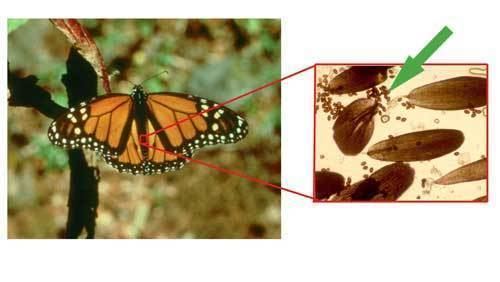
In the temperate areas that it doesn't die back over winter (or even, in some cases, where it doesn't die back during the season like other milkweeds), it can become a host for OE. OE is short for Ophryocystis elektroscirrha, and its a protozoan parasite that can and frequently does infect monarchs. As infected monarchs visit different plants--whether its to drink nectar, to lay eggs, or even just doing a fly-by of the garden--they drop spores from their wings that can then fall onto the leaves, flowers, and even any eggs already on the plant. As caterpillars hatch and begin to eat the plant, they ingest the protozoan, which begins the cycle anew. High OE levels in adult monarchs have been linked to lower migration success, reductions in body mass, lifespan, mating success, and flight ability. And that's if the caterpillars don't succumb prematurely to the infection, or if they're able to even exit their cocoon and fly once they finish pupating--deformed wings are frequently a result after infections. Now, OE is a parasite that's evolved alongside monarchs--and monarchs are usually able to handle an infection just fine, but if they're carrying a high load? That's where the problem lies.

What role does tropical milkweed play in this? Most milkweeds die back after blooming, at least once or even twice per season--and the parasite dies alongside them. As native milkweeds push out fresh foliage, its parasite-free, offering a healthy new buffet for caterpillars. Tropical milkweed... doesn't do that. If nothing's done, (at least in my state of Florida) tropical milkweed will stay fresh and green all the way up until the first real frost hits way in December--and that's if there's a hard frost, when you travel farther south. And during all that time, OE levels are building up on the leaves, so any future caterpillars that feed on this plant are doomed the instant their egg is laid on a leaf.
Its not that it's utterly impossible for a monarch to get infected with OE on any other kind of milkweed--monarchs are known for their traveling habits, and the chances of them happening upon a different milkweed plant than the tropical milkweed in your backyard is pretty high. But whereas native milkweeds die back and essentially reboot their system with fresh, disease-free leaves at least once a season, tropical milkweeds are like downloading a virus onto a USB and then passing it to your friends.
But that's not all, either. Time for kick 2.
Migration Interruption

Sit with me a moment and imagine you're a monarch butterfly. You're hardwired to know that as your food source starts dwindling at home, its time to get a move on and fly on down to the family's vacation home in Mexico for the winter. The buffets shut down, you exit stage left. But on your way to what's essentially a season-long smorgasbord with friends, you find... a buffet is still open. You're supposed to leave when the buffets are shutting down, but this one's up and running, lights are on, and plenty of people are there having fun, so you step in to relax. You'll take your trip later.
Now imagine a bit after you entered that buffet, the staff stuffed the guests into the walk-in freezer, locked the door, turned off all the lights, locked up the building, and left.
That's basically what tropical milkweed being 'evergreen' is doing to monarch butterflies in the fall and winter seasons. In areas up north where it can stay growing far later into the fall/winter months--or worse, in the south, where it can basically be evergreen until a hard frost (if one even happens), it can interrupt the monarchs' iconic migration cycle. They'll stay in place and continue breeding, living life like they aren't supposed to be a country away--until a frost hits, and they're dead in a snap. And if there's not a frost, you're getting a bunch of OE spore-ridden monarchs flying around a bunch of OE spore-ridden milkweed plants that the butterflies who followed the rules and overwintered in Mexico are gonna be returning to. POV you're starting a family in a house so laden with asbestos and black mold that there's practically black dust floating around.
This is already pretty bad. Can it get worse? Absolutely. Kick number 3.
It's Pretty Invasive (in the US)
It's fast growing, its eager to go to seed (so eager that it can flower and produce seed at the same time), its growing all throughout winter--which would be great, if it were native to the United States. Unfortunately, it isn't! As one could imply from the name, Mexican butterfly weed is native to--well--Mexico, as well as the Caribbean, South America, and Central America.
Further North into the states, and it's more of an annual--a plant that lasts maybe a year tops, dies back permanently, and you go buy more next year, or start from seed. Further south? It's a perennial, baby--which means its got even more time to spread its seeds and really thrive in the warmer climates of places like Florida, Texas, California, etc. Not to mention, as climate change makes temperatures rise, places where tropical milkweed is an annual may quickly begin seeing it stand strong all year...
I won't pretend to be a Professional Milkweed Identifier. I'm getting better at it with time, but I'm not a pro. But most of the time I go outside and I go 'oh, that's a milkweed!' its tropical milkweed. I've seen it grow in the sidewalk cracks of a gardening store I go to--its a clean four feet tall, always flowering, always making seeds. Tropical Milkweed is eager to escape the confines of your backyard, or make more plants in your backyard--I started with 5 plants one year, and the next year I had seven, then twelve, and that's just the ones that didn't get mowed over in the seedling stage...
But wait, that's not all! Kick number 4, baby!
Toxic to Monarchs????
According to the Xerces Foundation, emerging research suggests that tropical milkweed may become toxic to monarch caterpillars when exposed to the warmer temperatures associated with climate change.
'What the fuck, I thought milkweed was good for monarchs! How the hell does that happen?!'
All milkweeds produce cardenolides in their sap--a type of steroid that are toxic to most insects (and even people). Milkweeds create it to repel herbivores that would munch on it otherwise--except for milkweed butterflies (Danainae family), like our legendary monarch, as well as the queen and plain tiger butterfly. Larvae eat up milkweed leaves like there's no tomorrow, to stock up on those cardenolides and become toxic to their vertebrate predators--except for a few species that have evolved to become cardenolide-tolerant (black-backed orioles and black-headed grosbeaks). But, when cardenolide concentrations are high enough, it's too strong for even monarch butterflies to withstand--they die because of the very plant that's supposed to give them life. Kinda fucked up. Comparatively, many native species have lower cardenolide levels--and don't immediately go into flux at higher temps like tropical milkweed does.
'Wait, Ani, if there's all these problems with tropical milkweed, why is it sold everywhere?'
Capitalism. The answer is capitalism.
Well, actually, its a bit more complicated than that but it's also still capitalism.

The very same things that make tropical milkweed so invasive and such an issue are what make it so incredibly popular to sell. It's fast growing, and eagerly starts from cuttings as well as from seeds--which is perfect for growing tons of plants in quick and easy batches to send to vendors all over and get a quick profit. It's easy to grow from the home gardener too--its resistant to most diseases, looks gorgeous almost year-round, is quick to return in many areas without even the slightest sign of a die-back, and is popular with monarchs and other pollinators. Want to start a pollinator garden with quick results? Plant milkweed--and when tropical milkweed is all that you see available when you walk into your beloved store, it's what most people are going to get without thinking twice. Not to mention, when you hear it starts quick from cuttings, and you really wanna get your friends and loved ones into pollinator gardening, well... you get well-meaning people sharing invasive plants with their homies, like I did in high school. I've been pollinator gardening for around sixish-sevenish years (I think) and I didn't even catch wind that tropical milkweed was invasive until three years in! To say I was mortified doesn't describe it fully.
'Wait, three years ago? So information about this has been out awhile! Why aren't more places selling native milkweeds by now?! Why are people still buying this invasive milkweed and not native ones?!'
It's capitalism again! But in a different way.
Compared to tropical milkweed, many other milkweeds are a lot more... finnicky to get started, or grow in general. Many of them are a lot slower to germinate, are more prone to failing as seedlings and falling victim to things like 'dampening off' or 'too many aphid' or 'the vibes were wrong.' If they do germinate, they're slower to get to size too--I've grown tropical milkweed from seed in solo cups and gotten something about four inches tall within maybe a month and a half. Some other milkweeds I've grown from seed take about a month and a half to get more than four leaves, or even poke their little green heads out of the dirt. In addition to this, milkweeds have taproots--and some are a lot more friendly to the concept of 'transplanting from a pot to the ground' or 'growing in a pot at all' than others, and tropical milkweed ranks at the top of that list again. Not to mention, their willingness and ability to overwinter in pots--many native milkweeds fail that test, meaning that even if all the resources and efforts are put into getting a milkweed to grow from seed, it won't survive longer than a year in that pot. Considering most milkweeds don't flower until a year or so into their growth, and it's easier to sell plants that are flowering... many plants are a tough sell.
Another reason? Some native milkweeds are way more picky about when they want to make seed pods, or what conditions their seeds want to be grown in. If the seeds are hard to obtain? Good luck growing them in a production greenhouse. Let alone finding seeds for sale to grow them yourself at home--in my hunt for native milkweed species, I've seen packets of ten seeds sold for twenty bucks, packets of 25 seeds sold for anywhere from 50 to 100--meanwhile, you can find dozens if not hundreds of tropical milkweed seeds sold in a pack for maybe a dollar or five.
Let's be real. Producers haven't figured out the magic ticket to pumping out native milkweeds like they have with tropical milkweed--as such, finding native milkweeds for sale is rare, and they're often pricier. And as someone who's been to a native plant sale and found the stands sold out of milkweeds not even 30 minutes into the event--you are likely not the only person wanting native milkweeds. It is war out there in the garden parties.
And that's assuming you've actually found native milkweed for sale! As you get better with milkweed IDs, you'll be able to clearly identify the liars who are telling you they've got something that they don't, but for those who aren't In The Know--if you see a milkweed labeled like a native milkweed and want to buy native milkweed, it might be too late by the time you realize you just got sold tropical milkweed with a mislabel. Whether its on accident or on purpose, it still bites.
I've asked some of my favorite, smaller greenhouses if they'd be willing to start selling native milkweeds. Most of the time I get an exasperated 'I would love to.' But they can only sell what the vendors can produce--so if they can't find a vendor that's selling swamp milkweed (or at least reliably), then they can't give me swamp milkweed when I poke my head in asking if they have any in stock. Of all the times I've gone to dozens of different green houses and gardening events, in different cities even, to see if they have any native milkweeds I've only had success a few times--one small vendor who only has them in stock at events sometimes (and that's if I don't show up late), and the one time I rolled into a not-big-box-but-not-small gardening store near my friends house after being sad that I couldn't find it at a different gardening event. And the one I found there was the last one they had in stock for the next month or two. Until The Vendors get better at growing native milkweeds, your best bet is going to be growing it from seed yourself, getting a start from a friend, or dumb luck at smaller nurseries and events. It's rough out here, friends.
Granted! Keep in mind! That whole last paragraph was personal anecdotes. It's entirely possible that other places' greenhouses have already caught on, and I'm simply in the shadowlands where nobody's selling native milkweeds except for once or twice a year and selling out within 20 minutes of opening their damn booth. And I've heard tell of people getting milkweed popping up willingly in their backyards by doing things as simple as not mowing. I pray you have better luck than I do, young Padawan.
Now, keep in mind, there are people actively working on this. Whether its a team of university scientists dedicating themselves to a project, or a few home-growers in a sunny backyard and a greenhouse doing their damn best to grow native milkweeds as efficiently as possible for themselves and their friends, there are people working on this, sharing advice and communicating online. This isn't some unresolved issue that no one has noticed. We just... aren't at the end post yet. Until then, we scrounge for what we can.
'Oh no, oh god, I have a bunch of tropical milkweed plants in my garden!! Am I a bad person?!?!'
No You Are Not A Bad Person For Growing Tropical Milkweed
And I'm perfectly honest about that. Because I'm here telling you this and I've still got tropical milkweed plants in my backyard. As that one comic once said, about 10,000 people learn something new every day, and unfortunately today that 'new thing' is a bit sad and a bit untimely. In full honesty, oftentimes in my brain I refer to Tropical Milkweed as Starter Milkweed--its what a lot of pollinator gardeners end up starting with, because its just so available! But! There are things that you can do to mitigate the Damage that tropical milkweed can bring to your backyard butterflies.
Step One: Cut back your milkweeds! At least once a year, maybe even twice a year if you want. This will force them to put out new growth, which will be free of OE spores and give monarchs on it a good head start against the Disease. But for sure, for sure, cut your milkweeds back in the fall--once October hits, I go into the backyard and I snip down everything that's tropical milkweed. Usually at this point (at least for me), the milkweeds don't try to grow back again until spring. This is to prevent monarchs from seeing a buffet and getting locked in the freezer.
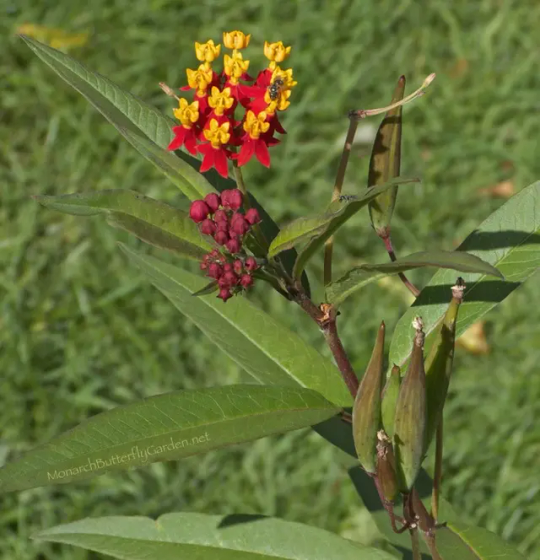
Step Two: Cut back seed pods! You would not believe how many seed pods milkweed makes. You see those little green footballs? You wanna snip these back ASAP. Even if they're tiny, but especially if they're bit. In peak flower production times, I'll go out there at least once a week and just do a look-back and cut them off. You can even yoink them off with your hands if you're in a rush--just don't get that sap into your eyes. If you do this, you're stopping seed production in its tracks--and don't forget, these plants want nothing more than to split those pods open and unleash a hellfire of flying seeds all over the place. They'll float on air, they'll float on water, they'll do whatever until they land on a prime patch of soil and get started.
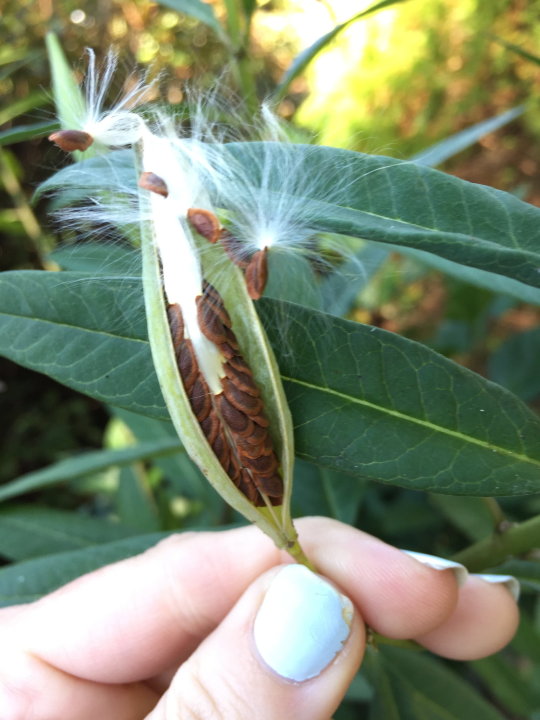
If you see these you're a tinge too late. But also still yoink that off and Dispose of it.
Step 3: Don't give cuttings to your friends. It's tempting. If you're raising caterpillars in a little enclosure and see that every time you refresh your cuttings, the old ones have tons of roots and are ready for a little pot of soil and a name tag? Don't. Resist the best you can. Dispose of your cuttings whenever you go in for a trim.
Step 4: Consider replacing them with something else! I know I already went off about just how hard it was to find native milkweeds for sale, how expensive and difficult they can be to grow--but they're not impossible to grow, and putting in the effort could be worth it! Even as I speak, I'm trying to add as many native milkweeds to my garden as possible--and when I've got something that grows reliably in my backyard, I will eagerly rip up my aging tropical milkweed plants and promptly toss them in the bin so i can put a new, better milkweed in its place. Native milkweeds are more likely to be suited to your environment, making it easier to maintain and more welcoming to the pollinators we gardeners want to help. Not to mention, a lot of them are way pettier than tropical milkweed (in my opinion). Do some hunting online to see what's native to your area--your state's extensions office will likely be great for this! You've likely got great variety--the state of Florida has 21 native milkweeds! Who knows how many your state has! (Not me, I am Floridian, and I am already getting dizzy trying to learn about all 21 of our milkweeds).
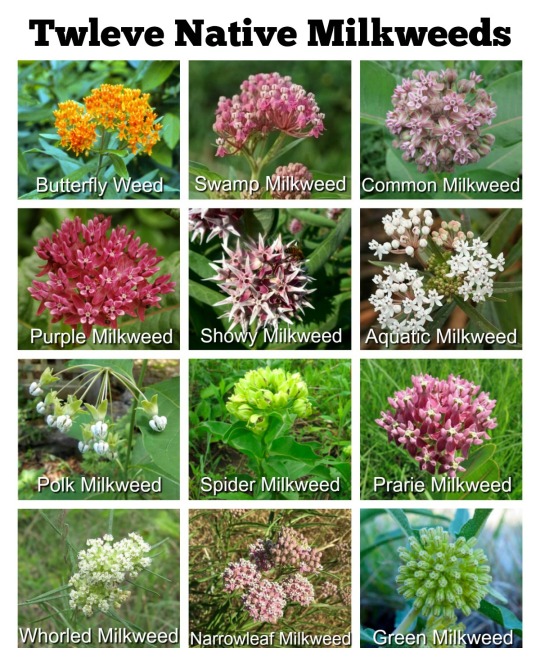
Conclusion!
Anyone who knows me knows I'm not gonna be the one to discourage someone from starting a garden, especially a pollinator gardener, and especially growing milkweed. But avoid tropical milkweed when you can--the harms it can cause far outweigh the quick satisfaction of a busy garden it can bring. Take some time to select a native plant more suited to your area, give it some friends and some time, and soon you'll have an amazing pollinator garden that'll be teeming with life!
#milkweed#tropical milkweed#asclepias curassavica#asclepias#outdoor gardening#succulents#bloodflower#pollinator garden#pollinator gardening#monarch butterfly#ani rambles#out of queue#what was it three hours ago that I was declaring that I wasn't gonna write up a long research post again?#now here i am at 3:30 am ranting about milkweed with like a dozen sources#granted this is nowhere NEAR as long as the biodiversity saga was BUT STILL#i told myself i was gonna write today... i meant one of my novels NOT RANTING ABOUT MILKWEED#if this post blows up this is gonna go on my wall of 'posts that i thought of on the toilet that got way more popular than I expected'#there's not a lot of posts on that wall maybe 2 or 3 but its weird that its happened that many times already
250 notes
·
View notes
Text
Phylum #4: Cnidaria!


An extremely varied phylum, recognizable by radial symmetry and stinging cells, Cnidaria encompasses jellyfish, corals, sea anemones and many more.
Cnidarians have a complicated life cycle, with either a medusa (jellyfish-like) form, a polyp (sea anemone-like) form, or often both! In jellyfish, the polyp will transform into a pancake stack of flat disks, each becoming a free-swimming medusa. "Immortal jellyfish" actually rejuvenate by going back to the polyp phase!
Both polyps and medusae show a variety of body plans. Sea anemones and small, self-regenerating hydras are both polyps, while corals are giant colonies of them. The medusa side isn't less diverse, with the immense siphonophores also being colonial organisms, reaching up to 50 meters in length!
Possibly the most unique cnidarians are myxozoans. These microscopic animals have simplified their body plan to the extreme, sometimes consisting of a single cell, living as parasites of fish and annelid worms. For a long time, they weren't believed to be animals at all, instead being classified as single-celled protozoans!


#forms and phyla#cnidaria#sea creatures#sea life#marine life#marine biology#jellyfish#sea anemone#coral#hydra#siphonophore#myxozoan
95 notes
·
View notes
Text
Brain fluid, Great ones, Blood and parasites.
I am replaying Bloodborne and I'm noticing a few new things.
I finally get to the research hall and read the brain fluids description again (in French & English)

Greyish amoeba-shaped brain fluid. Wobbles and bounces.
Extracted from a patient whose head expanded until that was all that they were.
In the early days of the Healing Church, the Great Ones were linked to the ocean, and so the cerebral patients would imbibe water, and listen for the howl of the sea. Brain fluid writhed inside the head, the initial makings of internal eyes. (…)
So… was i supposed to found out myself they actually have parasite inside ??
So one thing you need to know is that "brain fluid" or cerebrospinal fluid (liquide céphalo-rachidien/cérébrospinal en VF) is a transparent liquid where you have your brain and inside your spine for your nerves. It doesn't quite fit what we have in game right ?
But they did add water in it, right ? It also said (but it's more clear in French that it have an amoeba (amibe) shape.
What's an amoeba ? from wikipedia : "(...) is a type of cell or unicellular organism with the ability to alter its shape (...) Amoeboid cells occur not only among the protozoa, but also in fungi, algae, and animals. Microbiologists often use the terms "amoeboid" and "amoeba" interchangeably for any organism that exhibits amoeboid movement."
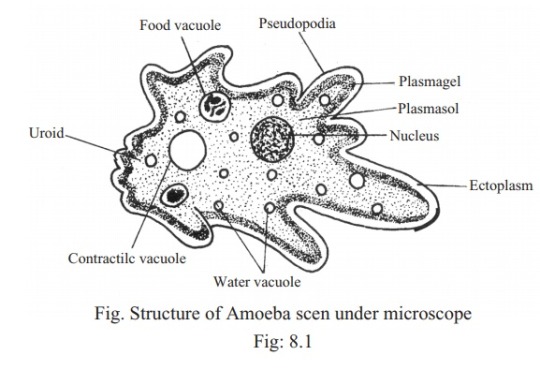
It's an eucaryote (membrane, cytoplasm and nucleus like our cells) and unicellular organism that can lived without and host in the earth or water for example (unlike our cells who need to be a part of a pluricellulaires organism).
But, there's some type of amoeba who act as parasite and actually can "eat" a brain💀 (actually it attacked the nervous system & cells from the cavity between the nose and brain ) do you see where I'm trying to get ?
The water they put inside the patients head... probably had microorganism inside it. If it's not the Kos parasites then others things really similar.
It will take too long to develop everything, maybe another day so really short : we know about the Kos parasite right ? And that Kos probably had parasites who infected and transformed the inhabitants of the Hamlet.
For the blood we literally have vermin, the loran silver beasts (+ the maggots), the bloodletting beast with the giant worms and the blood dregs. (the eyes that turned blind some parasite do that in real life too)
I thought at first that what caused the beast plague was "infected cells' like cancerous cells that created more organic materials, mutated their host and boom. And not just some bacteria or viruses (that is possible too XD but also vermin are those arthropods like parasites so I was a bit confused.
But now ! If we need to have a more scientifically and realistically approach about what happened in Bloodborne (and not just boom great ones dream magic) I think it can be caused by unicellular beings who composed the great ones and mess with everyone 👍
I mean diseases and organism disfunction (of the neural system for ex) are caused on a cellular if not molecular level after all (how molecules and drugs act in the neurons and synapses of the brain is really fascinating ! But it’s not easy to learn)
Also why are great ones so close to the first protozoan cells organism for some reason ?! There's multicellular organism I guess but exist on different planes of existence (if they're not aliens or smt) but bc of the parasites blood and all (odeon is kinda blood/ what we have in the blood) so they're probably really really old forms of life you (like unicellular organisms).I guess we could say that great ones are parasites of the mind !👈 👈 (ok enough of today)
Little bonus : the first unicellular appear between 3,5 and 3,8 billion years. The multicellular appeared 2 billions years ago, our Earth have 4,5 billions years, our solar system just a bit more and the universe is 13,8 billions years old. Homo sapiens sapiens (us) is like 200 000 years old 💀 but don't worry the homininae line appeared 10 million years ago!
Hey you know we're closer to the dinosaurs who lived at the end of the cretaceous (64Ma) than between the Dino of the cretaceous and the beginning to the triassic (first Dino : 230/250 Ma)? CRAZY HMMM ??????
Anyway I do believe Bloodborne universe is actually as fantastic as dark souls or Elden Ring and not super ultra realistic like our own world. Some things just doesn't make sense realistically and maybe don't have a possible realistic and scientific explanation (the dreams, great ones etc) but it's cool to try to used sciences to explain things in the universe ! That make its own world more coherent in its own logic I believe ! (it's like you know sci fi movies, Frankenstein and all. it's not possible in real life but based on true sciences stuff).
#bloodborne#bloodborne analysis#bloodborne theory#research hall#thank you my 1y in biology at uni a few years ago!#if it's that it's crazy all the research they put into this wow!#sorry I lost it at the end XD#let's explain fantastic and unrealistic worlds with fantastic sciences from it's own universe!#is this RE4?! the parallels are making me insane
129 notes
·
View notes
Note
Would said non-fatal parasite that causes lethargy happen to be coccidia?
I believe I decided on a tapeworm, not a protozoan, but it doesn't really matter in the end. Parasites are gross and I don't like looking at them so I didn't research too heavily, and just went off my prior knowledge.

Bluebellkit is my favorite.
59 notes
·
View notes
Text
“phobia safe” tick facts post
*LINKS* CONTAIN TICK PHOTOS, POST ITSELF DOES NOT!

Ticks are some of my favorite animals, but some species are a public health threat. It’s important to understand dangerous things, but also understand them as a part of nature, so this will be a little like my bug facts post for just ticks specifically. Links are provided as information sources but most will contain photographs of actual ticks, in case that isn’t something you want to see unexpectedly.
-----TICK SAFETY AND MYTH-BUSTING------
Ticks are arachnids. If it has six legs, antennae or wings, it is not a tick. A tick has a rounded body and eight obvious legs, with no other appendages.
Mites are their closest relatives. Many large mites can be mistaken for ticks, but will have differences in body shape and leg arrangement.
Know their shape. Even if just a photograph does make you squeamish, you will want to know what a tick looks like before you might go hiking or camping. Their flattened bodies are seed-like, their mouthparts stick out the front end in roughly a rectangle, and the eight legs are gently “curled” or “curved.” A tick never has sharply jointed legs like a spider or insect!
Ticks can be dangerous in two ways. some tick species actually produce venom that can cause paralysis, while others can be vectors for viruses, bacterial infections or protozoan parasites.
Ticks cannot transmit just any disease. A pathogen has to adapt specifically to take advantage of ticks as vectors, and are thus referred to as tick-borne illnesses. Here’s a list of them. A tick must also pick up a disease somewhere, so for instance, every individual lyme tick does not always harbor lyme disease!
Ticks don’t fly or jump, but wait in ambush. To find its next host, a tick goes “questing” (video) and will typically perch on foliage with its forelegs outstretched, especially grasses and dry shrubbery.
Taller grass doesn’t necessarily worsen tick populations. If there are ticks in your yard, you won’t reduce them by mowing more frequently. However, shorter grass makes it easier to avoid ticks, since taller grass gives them more vertical space to climb.

*Giemurou from Tensou Sentai Goseiger is, of all things, a tick-themed Kappa
Ticks are attracted to CO2. In another post I talked about how “dry ice” is sold in some places for camping coolers, but that it happens to attract ticks like mad. If it’s legal to purchase in your area, a little dry ice can even be used to attract and trap ticks in your own yard.
"Our” ticks attach firmly and must be removed carefully. The ticks that tend to attack humans are “hard ticks,” which feed long-term by embedding their mouthparts in the skin, where they may remain for several days.
DO NOT smother, burn or squeeze an attached tick. This can force the tick to regurgitate directly into the host’s blood stream, increasing the likelihood of infection. See the previous link for a graphic on safer removal.
If you remove an attached tick, take it to a doctor. Keep the tick as intact as possible in a tight container, and call a doctor or hospital as soon as you can. Many places can have a tick tested for infectious agents.
Watch out for their eggs, too. Tick eggs are tiny, sticky and laid in blobby clumps resembling fish roe!
Hard ticks swell after feeding. A flat tick is a tick that hasn’t bitten anyone yet. A round, bloated tick is a tick that has recently finished a blood meal, and sometimes a female that has gone on to mate and fill with eggs.
Ticks are NOT related to fleas. I’ve seen some people use the two interchangably. Fleas are actual insects, and dealing with them is a very different matter.
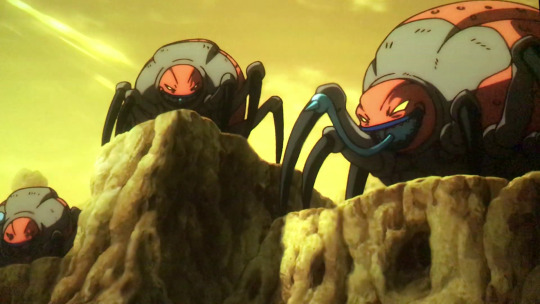
*What were dubbed as "vampa beetles” from Dragonball Super: Broly are actually giant ticks!
-------TICK BIOLOGY FACTS-------
I think I’ve covered everything you need to know about ticks for your physical well being, but I think it’s equally important to understand and respect dangerous wildlife as a part of nature, so the following is just for educational fun.
It’s not their fault they’re such a problem. As with so many other things, the threat of ticks has been greatly exacerbated by human recklessness. Deforestation and climate change have greatly expanded their range while a loss of natural predators has boosted their populations.
Sloths have special giant ticks. Many ticks find a sloth’s body inhospitable, but one of the largest on Earth feeds on sloths exclusively.
There are two major types of tick, but one just doesn’t bother with us. “Soft ticks” are named for their leathery appearance, and often look “headless” with their mouthparts underneath the body. Some species will bite humans and can transmit disease, but the majority of soft ticks target birds, bats or certain reptiles. These ticks also feed for only a few seconds or minutes at a time, rather than attaching to skin!
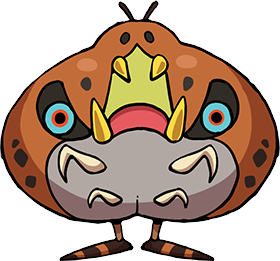
*“Daniel” the tick Yo-kai appeared in Yokai Watch 4! I am now almost out of pop culture ticks that don’t look like the real thing. That was fast :(
At least one known tick practices maternal care; it also “goes vegan” as it matures. Antricola marginatus is a soft tick found in bat caves, and as an adult, it switches from feeding on blood to eating bat droppings on the cave floor. However, since the young still require a blood meal to develop, the mother will regularly carry them all the way up the cave wall to feed on bats, wait for them to climb back onto her dish-shaped body, then return to the cave floor so she can eat more poop.
Ticks can be incredibly long lived without food. One researcher kept a small colony of soft ticks for 27 years without feeding them blood ever again. This only ended with his retirement from the lab; we still don’t know how much longer they might have survived.
Ticks invented their own unique sensory organs. The “haller’s organs” are a tiny pit in each of a tick’s front legs, which detect not only the CO2 produced by host animals but can measure surrounding temperature and humidity.
Ticks also have a “mystery” anatomical feature. In this microscopy photo of a tick’s mouthparts, you’ll see two porous depressions highlighted in pink. These are present only on female ticks, and we don’t know what they do.
A tick’s “head” and “body” are one big segment, sometimes with eyes. This is also in my general bug facts post! What people think is the “head” of the tick is just a capsule housing all the mouth parts. A tick is anatomically more like one big walking “head” and some species have a pair of little, well developed eyes on their sides.
Immature ticks have six legs. Eight legs aren’t really a requirement to be an arachnid, just the maximum number any true arachnid normally has. A new pair of legs develop with the tick’s first molt, shortly after its first blood meal.
Ticks can be beautifully patterned. Link goes to two rhinoceros ticks with amazing markings!
Ticks are a part of the nutrient cycle. You’ll often hear that a given creature is important as food for other animals, but it does go a bit deeper than that: by feeding on the blood of larger animals, ticks are “taking back” nutrients “locked away” in those animals, making them available again not only when the ticks are eaten by other predators, but even when the surviving ticks pass away and decompose! The total biomass of parasites like ticks is a constant supply of energy returning to the local food web each and every day.
Parasites in general guide evolution and shape ecosystems. Everything about a given animal is an adaptation to deal with its environment, and as parasites are present in all environments, they have an influence on every aspect of their host species. Ectoparasites like ticks drive the evolution of such behaviors as social grooming, mud-wallowing, mate selection, migration and even where or when an animal grazes.
The best tick control will always be natural predation. Anything that will eat small arthropods will eat a tick, and anything that will eat a tick-infested mammal is both directly eliminating ticks and regulating their long term blood sources. You may know that opossums eat ticks, but it’s probably not any more than any other omnivore or insectivore, and most important of all may be snakes!
988 notes
·
View notes
Text
but are we certain consuming elevated concentrations of destiel isn't like directly snorting a parasitic protozoan ???
toxoplasmosis gondiistiel ???
13 notes
·
View notes
Text
October 28th, 2023

Oriental Blue Fly (Chrysomya megacephala)
Distribution: Found throughout the palearctic, but especially common in Indomalayan and Australasian realms; also found in Japan, New Zealand, Africa and throughout the Americas. In North America, the oriental blue fly has been found in Texas, California, Louisiana, Tennessee and Hawaii.
Habitat: Found just about anywhere, but especially common around human dwellings, especially where decomposing matter is common. Not usually found indoors.
Diet: Larvae feed on the soft tissues of mammals and birds, such as meat and organs, and show a preference towards fish. Adults feed on decaying fish, meat and excrement, as well as sweet substances such as fruit.
Description: The oriental blue fly has a particular importance in human affairs in both the fields of medicine and forensic entomology. This fly can be responsible for myiasis, the infestation of live tissue by fly larvae, in humans, fish and livestock. These flies are also carriers for pathogens such as bacteria, protozoan cysts and parasitic worm eggs, due to the fact that they will land on excrement, then land on human food.
On the bright side, the presence of the oriental blue fly can be a asset for forensic investigators, who can use its presence on a cadaver in order to estimate its time of death. They can also be used to detect certain compounds in bodies too decomposed to evaluate; if certain compounds are in the flesh of a cadaver, they will be passed on to the larvae which feed on it, allowing the larvae to be tested for these compounds. Oriental blue flies are also useful as pollinators of mango fruit.
(Image by Muhammad Mahdi Karim)
11 notes
·
View notes
Text
A common medical parasite with a symbiotic relationship with humanoids is P. vengativa util. P. util is a predatory, hyperparasitoid protozoa distantly related to Toxoplasma Gondii that inhabits the digestive system of species commonly living in low-population areas.
This protozoan is widely used as parasitic prevention due to the production of a chemical similar to clindamycin during the organism’s reproductive stage. Although not harmful to humanoids, P. util reproduces within other intestinal parasites, either rendering them infertile or killing them, while the chemical it produces prevents further infection. Most organisms with P. util rarely, if ever, have parasetic infactions, most of which are mild and go away quickly.
Commonly regarded as normal bacterial flora, most humanoids will ingest oocysts of the protozoa at a young age or gain them in fetal development to prevent parasitic infections related to or as a cause of ingesting contaminated water, raw meat or other infected substances.
In addition to sterilizing multicellular parasites, P. util also consumes bacteria typically associated with gastroenteritis in direct response to the body’s immune response. It also consumes some types of stomach flora in herbivorous humanoids, lack of which can be prevented though ingestion of probiotics and fermented foods.
It is typical for oocysts to be ingested at a young age to prevent instability of stomach flora during adulthood (after the body’s immune system has fully developed), which can cause complications such as stomach upset, acid reflux and temporary development of allergies while the digestive ecosystem regains balance. These conditions may be permanent in some cases.
3 notes
·
View notes
Text
I’m just saying my life would be cooler if I was an anthrax spore or perhaps a parasitic protozoan
10 notes
·
View notes
Note
Boop you’re a cat!

Cat feces is not the only way that Toxoplasma gondii, the protozoan parasite that causes the disease Toxoplasmosis, is spread. It is the vector that everyone remembers, though.
Also, shout out to long dead memes from when I was in high school.
#my little pony#my litte pony friendship is magic#mlp fim#ask pony blog#pony ask blog#ask blog#anon ask#anonymous ask#askpokeeosin#toxoplasma gondii#cat#toxoplasmosis
10 notes
·
View notes